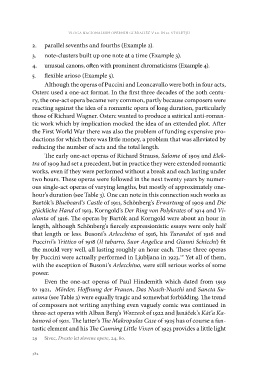Page 384 - Weiss, Jernej, ur. 2019. Vloga nacionalnih opernih gledališč v 20. in 21. stoletju - The Role of National Opera Houses in the 20th and 21st Centuries. Koper/Ljubljana: Založba Univerze na Primorskem in Festival Ljubljana. Studia musicologica Labacensia, 3
P. 384
vloga nacionalnih opernih gledališč v 20. in 21. stoletju
2. parallel sevenths and fourths (Example 2).
3. note-clusters built up one note at a time (Example 3).
4. unusual canons, often with prominent chromaticisms (Example 4).
5. flexible arioso (Example 5).
Although the operas of Puccini and Leoncavallo were both in four acts,
Osterc used a one-act format. In the first three decades of the 20th centu-
ry, the one-act opera became very common, partly because composers were
reacting against the idea of a romantic opera of long duration, particularly
those of Richard Wagner. Osterc wanted to produce a satirical anti-roman-
tic work which by implication mocked the idea of an extended plot. After
the First World War there was also the problem of funding expensive pro-
ductions for which there was little money, a problem that was alleviated by
reducing the number of acts and the total length.
The early one-act operas of Richard Strauss, Salome of 1905 and Elek-
tra of 1909 had set a precedent, but in practice they were extended romantic
works, even if they were performed without a break and each lasting under
two hours. These operas were followed in the next twenty years by numer-
ous single-act operas of varying lengths, but mostly of approximately one-
hour’s duration (see Table 3). One can note in this connection such works as
Bartók’s Bluebeard’s Castle of 1911, Schönberg’s Erwartung of 1909 and Die
glückliche Hand of 1913, Korngold’s Der Ring von Polykrates of 1914 and Vi-
olanta of 1916. The operas by Bartók and Korngold were about an hour in
length, although Schönberg’s fiercely expressionistic essays were only half
that length or less. Busoni’s Arlecchino of 1916, his Turandot of 1916 and
Puccini’s Trittico of 1918 (Il tabarro, Suor Angelica and Gianni Schicchi) fit
the mould very well, all lasting roughly an hour each. These three operas
by Puccini were actually performed in Ljubljana in 1923.29 Yet all of them,
with the exception of Busoni’s Arlecchino, were still serious works of some
power.
Even the one-act operas of Paul Hindemith which dated from 1919
to 1921, Mörder, Hoffnung der Frauen, Das Nusch-Nuschi and Sancta Su-
sanna (see Table 3) were equally tragic and somewhat forbidding. The trend
of composers not writing anything even vaguely comic was continued in
three-act operas with Alban Berg’s Wozzeck of 1922 and Janáček’s Kát’a Ka-
banová of 1921. The latter’s The Makropulos Case of 1925 has of course a fan-
tastic element and his The Cunning Little Vixen of 1923 provides a little light
29 Sivec, Dvesto let slovene opere, 24, 80.
382
2. parallel sevenths and fourths (Example 2).
3. note-clusters built up one note at a time (Example 3).
4. unusual canons, often with prominent chromaticisms (Example 4).
5. flexible arioso (Example 5).
Although the operas of Puccini and Leoncavallo were both in four acts,
Osterc used a one-act format. In the first three decades of the 20th centu-
ry, the one-act opera became very common, partly because composers were
reacting against the idea of a romantic opera of long duration, particularly
those of Richard Wagner. Osterc wanted to produce a satirical anti-roman-
tic work which by implication mocked the idea of an extended plot. After
the First World War there was also the problem of funding expensive pro-
ductions for which there was little money, a problem that was alleviated by
reducing the number of acts and the total length.
The early one-act operas of Richard Strauss, Salome of 1905 and Elek-
tra of 1909 had set a precedent, but in practice they were extended romantic
works, even if they were performed without a break and each lasting under
two hours. These operas were followed in the next twenty years by numer-
ous single-act operas of varying lengths, but mostly of approximately one-
hour’s duration (see Table 3). One can note in this connection such works as
Bartók’s Bluebeard’s Castle of 1911, Schönberg’s Erwartung of 1909 and Die
glückliche Hand of 1913, Korngold’s Der Ring von Polykrates of 1914 and Vi-
olanta of 1916. The operas by Bartók and Korngold were about an hour in
length, although Schönberg’s fiercely expressionistic essays were only half
that length or less. Busoni’s Arlecchino of 1916, his Turandot of 1916 and
Puccini’s Trittico of 1918 (Il tabarro, Suor Angelica and Gianni Schicchi) fit
the mould very well, all lasting roughly an hour each. These three operas
by Puccini were actually performed in Ljubljana in 1923.29 Yet all of them,
with the exception of Busoni’s Arlecchino, were still serious works of some
power.
Even the one-act operas of Paul Hindemith which dated from 1919
to 1921, Mörder, Hoffnung der Frauen, Das Nusch-Nuschi and Sancta Su-
sanna (see Table 3) were equally tragic and somewhat forbidding. The trend
of composers not writing anything even vaguely comic was continued in
three-act operas with Alban Berg’s Wozzeck of 1922 and Janáček’s Kát’a Ka-
banová of 1921. The latter’s The Makropulos Case of 1925 has of course a fan-
tastic element and his The Cunning Little Vixen of 1923 provides a little light
29 Sivec, Dvesto let slovene opere, 24, 80.
382


